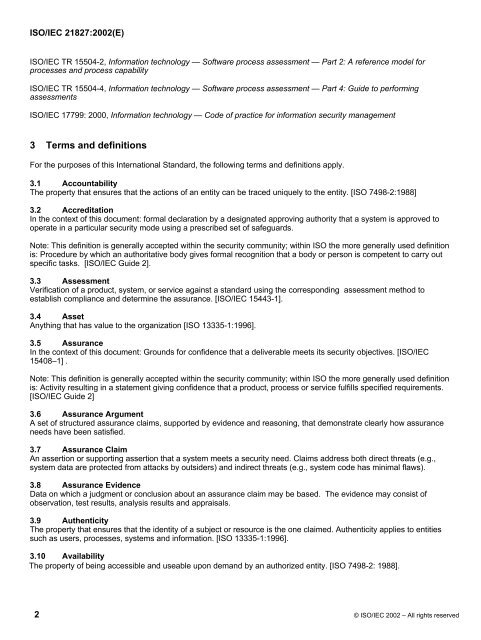ISO/IEC 21827
ISO/IEC 21827
ISO/IEC 21827
Create successful ePaper yourself
Turn your PDF publications into a flip-book with our unique Google optimized e-Paper software.
<strong>ISO</strong>/<strong>IEC</strong> <strong>21827</strong>:2002(E)<br />
<strong>ISO</strong>/<strong>IEC</strong> TR 15504-2, Information technology — Software process assessment — Part 2: A reference model for<br />
processes and process capability<br />
<strong>ISO</strong>/<strong>IEC</strong> TR 15504-4, Information technology — Software process assessment — Part 4: Guide to performing<br />
assessments<br />
<strong>ISO</strong>/<strong>IEC</strong> 17799: 2000, Information technology — Code of practice for information security management<br />
3 Terms and definitions<br />
For the purposes of this International Standard, the following terms and definitions apply.<br />
3.1 Accountability<br />
The property that ensures that the actions of an entity can be traced uniquely to the entity. [<strong>ISO</strong> 7498-2:1988]<br />
3.2 Accreditation<br />
In the context of this document: formal declaration by a designated approving authority that a system is approved to<br />
operate in a particular security mode using a prescribed set of safeguards.<br />
Note: This definition is generally accepted within the security community; within <strong>ISO</strong> the more generally used definition<br />
is: Procedure by which an authoritative body gives formal recognition that a body or person is competent to carry out<br />
specific tasks. [<strong>ISO</strong>/<strong>IEC</strong> Guide 2].<br />
3.3 Assessment<br />
Verification of a product, system, or service against a standard using the corresponding assessment method to<br />
establish compliance and determine the assurance. [<strong>ISO</strong>/<strong>IEC</strong> 15443-1].<br />
3.4 Asset<br />
Anything that has value to the organization [<strong>ISO</strong> 13335-1:1996].<br />
3.5 Assurance<br />
In the context of this document: Grounds for confidence that a deliverable meets its security objectives. [<strong>ISO</strong>/<strong>IEC</strong><br />
15408–1] .<br />
Note: This definition is generally accepted within the security community; within <strong>ISO</strong> the more generally used definition<br />
is: Activity resulting in a statement giving confidence that a product, process or service fulfills specified requirements.<br />
[<strong>ISO</strong>/<strong>IEC</strong> Guide 2]<br />
3.6 Assurance Argument<br />
A set of structured assurance claims, supported by evidence and reasoning, that demonstrate clearly how assurance<br />
needs have been satisfied.<br />
3.7 Assurance Claim<br />
An assertion or supporting assertion that a system meets a security need. Claims address both direct threats (e.g.,<br />
system data are protected from attacks by outsiders) and indirect threats (e.g., system code has minimal flaws).<br />
3.8 Assurance Evidence<br />
Data on which a judgment or conclusion about an assurance claim may be based. The evidence may consist of<br />
observation, test results, analysis results and appraisals.<br />
3.9 Authenticity<br />
The property that ensures that the identity of a subject or resource is the one claimed. Authenticity applies to entities<br />
such as users, processes, systems and information. [<strong>ISO</strong> 13335-1:1996].<br />
3.10 Availability<br />
The property of being accessible and useable upon demand by an authorized entity. [<strong>ISO</strong> 7498-2: 1988].<br />
2 © <strong>ISO</strong>/<strong>IEC</strong> 2002 – All rights reserved
















